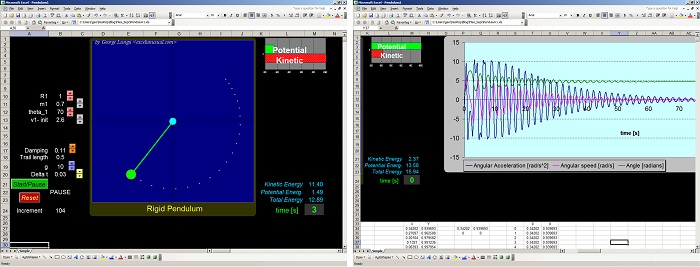This is a basic pendulum model in Excel. Enjoy!
This is an animated Excel model of a pendulum that you can download here. For fast modeling speed, please use older versions of excel (1997-2003). In the following section, background information about pendulums in general will be presented:
Pendulum meaning, a simple pendulum definition, what is a pendulum?
A pendulum is an oscillatory device made up of a concentrated weight (or a bob), suspended from an arm (or a rod). The rod has the bob at one end and it is hinged on a fixture at the other end. The ideally frictionless hinge is called a pivot or a fulcrum.
In an ideal pendulum the bob carries all the mass and the rod is mass-less. This device moves back and forth around the position of equilibrium under the force of gravity acting on the bob. The rod doesn’t need to be rigid, it can as well be a string.
Pendulum history
One of the oldest documented existence of a pendulum is by the Chinese who used it as a seismic detector (to sense earthquakes).
Galileo Galilei initiated the first scientific analysis of a pendulum around 1602 A.D.
He was inspired to study the pendulum by observing the oscillation of a chandelier in the cathedral of Pisa. He also found the property called isochronism, which means that the oscillation period of a pendulum is almost insensitive to it’s amplitude of motion. Another aspect he discovered was that the mass of the bob does not influence the oscillation period and also that that the period is proportional to the square root of the length of the suspending rod.
Types of pendulums, the period of a pendulum equation formula
There are variations of the regular pendulums. A compound pendulum has an extended mass, and is able to move back and forth horizontally. The oscillation period of the pendulum formula can be easily derived and calculated. There is a type of reversible pendulum or compound pendulum used for measuring the acceleration of gravity. It is called Kater’s pendulum.
Thinking about pendulums in science of Aristotle, which at that time was as yet the prevalent method to clarify the conduct of bodies close to the Earth, a substantial body (that is, one in which the component earth prevailed) looked for its normal place, the focal point of the universe. The forward and backward movement of a heavy body suspended from a rope was subsequently not a marvel that could clarify or outline much. It was outside the worldview having no influence on the period of the pendulum equation.
Galileo’s influence in the study of the gravitational pendulum
Galileo was shown Aristotelian material science at the college in the city of Pisa. Be that as it may the pendulum formula physics, he rapidly started scrutinizing this approach in the analysis of the gravitational pendulum. Where Aristotle had adopted a subjective and verbal strategy towards the oscillating physics of the pendulum, Galileo built up a quantitative and scientific approach.
Where the Aristotelians contended that heavier bodies fell speedier than lighter ones in a similar medium, Galileo, from the get-go in his vocation, came to trust that the distinction in speed relied upon the densities of the bodies. Where Aristotelians kept up that without the opposing power of a medium a body would travel boundlessly quick and that a vacuum was hence inconceivable, Galileo in the end came to trust the pendulum frequency that in a vacuum all bodies would fall with a similar speed, and that this speed was relative to the season of fall.



Hi George,
Are you planning to post a tutorial on this?
regards,
Jagmohan
Jagmohan, I should since it’s a very easy one (easier than the spring mass damper) and some people would probably be interested. Give me some time since I need to finish some other stuff first. Try taking a jab at it yourself first. George